The NVIDIA GeForce GTX 780 Ti Review
by Ryan Smith on November 7, 2013 9:01 AM ESTOverclocking
Finally, let’s spend a bit of time looking at the overclocking prospects for the GTX 780 Ti. Although GTX 780 Ti is now the fastest GK110 part, based on what we've seen with GTX 780 and GTX Titan there should still be some headroom to play with. Meanwhile there will also be the matter of memory overclocking, as 7GHz GDDR5 on a 384-bit bus presents us with a new baseline that we haven't seen before.
| GeForce GTX 780 Ti Overclocking | ||||
| Stock | Overclocked | |||
| Core Clock | 876MHz | 1026MHz | ||
| Boost Clock | 928MHz | 1078MHz | ||
| Max Boost Clock | 1020MHz | 1169MHz | ||
| Memory Clock | 7GHz | 7.6GHz | ||
| Max Voltage | 1.187v | 1.187v | ||
Overall our overclock for the GTX 780 Ti is a bit on the low side compared to the other GTX 780 cards we’ve seen in the past, but not immensely so. With a GPU overclock of 150MHz, we’re able to push the base clock and maximum boost clocks ahead by 17% and 14% respectively, which should further extend NVIDIA’s performance lead by a similar amount.
Meanwhile the inability to unlock a higher boost bin through overvolting is somewhat disappointing, as this is the first time we’ve seen this happen. To be clear here GTX 780 Ti does support overvolting – our card offers up to another 75mV of voltage – however on closer examination our card doesn’t have a higher bin within reach; 75mV isn’t enough to reach the next validated bin. Apparently this is something that can happen with the way NVIDIA bins their chips and implements overvolting, though this the first time we’ve seen a card actually suffer from this. The end result is that it limits our ability to boost at the highest bins, as we’d normally have a bin or two unlocked to further increase the maximum boost clock.
As for memory overclocking, we were able to squeeze out a bit more out of our 7GHz GDDR5, pushing our memory clock 600MHz (9%) higher to 7.6GHz. Memory overclocking is always something of a roll of the dice, so it’s not clear here whether this is average or not for a GK110 setup with 7GHz GDDR5. Given the general drawbacks of a wider memory bus we wouldn’t be surprised if this was average, but at the same time in practice GK110 cards haven’t shown themselves to be as memory bandwidth limited as GK104 cards. So 9%, though a smaller gain than what we’ve seen on other cards, should still provide GTX 780 Ti with enough to keep the overclocked GPU well fed.
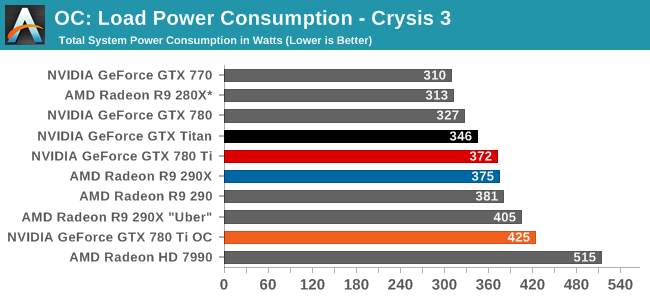
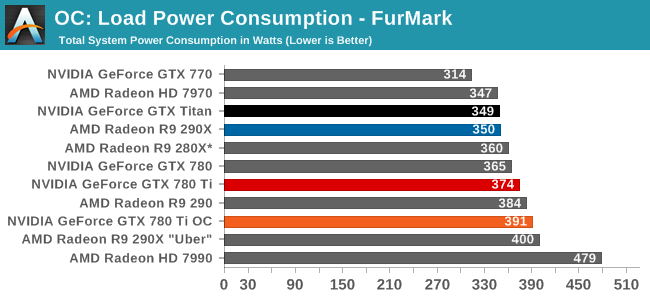
Starting as always with power, temperatures, and noise, we can see that overclocking GTX 780 Ti further increases its power consumption, and to roughly the same degree as what we’ve seen with GTX 780 and GTX Titan in the past. With a maximum TDP of just 106% (265W) the change isn’t so much that the card’s power limit has been significantly lifted – as indicated by FurMark – but rather raising the temperature limit virtually eliminates temperature throttling and as such allows the card to more frequently stay at its highest, most power hungry boost bins.
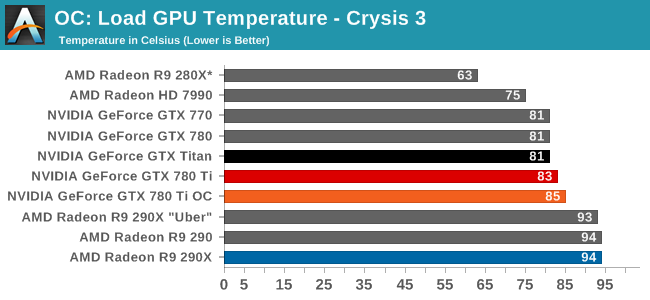

Despite the 95C temperature target we use for overclocking, the GTX 780 Ti finds its new equilibrium point at 85C. The fan will ramp up long before it allows us to get into the 90s.
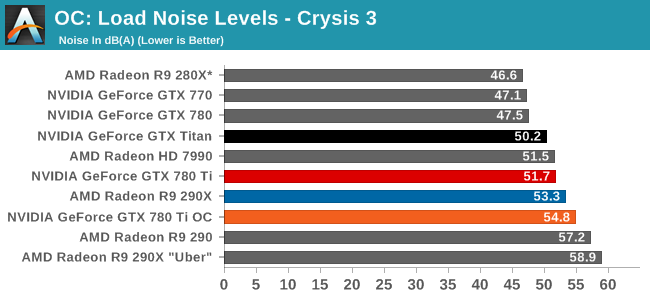
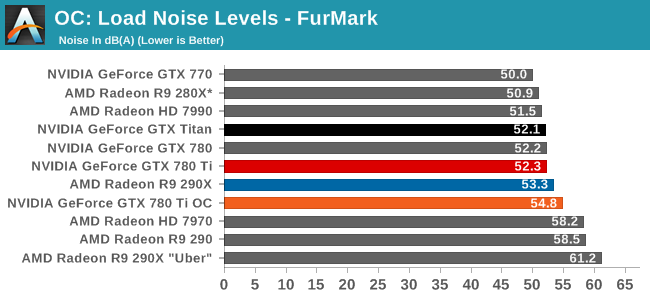
Given the power jump we saw with Crysis 3 the noise ramp up is surprisingly decent. A 3dB rise in noise is going to be noticeable, but even in these overclocked conditions it will avoid being an ear splitting change. To that end overclocking means we’re getting off of GK110’s standard noise efficiency curve just as it does for power, so the cost will almost always outpace the payoff on a relative basis.
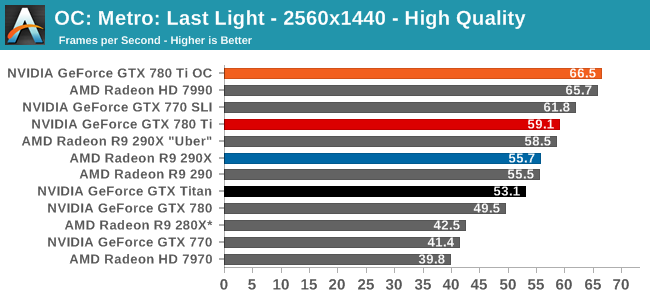
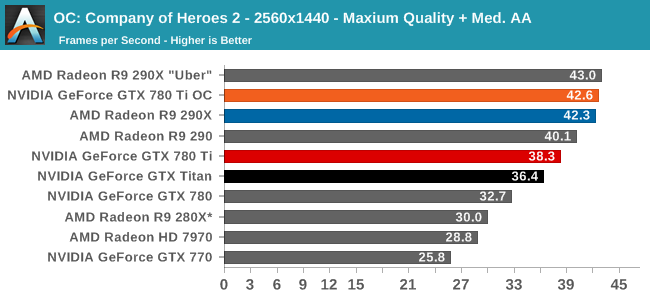
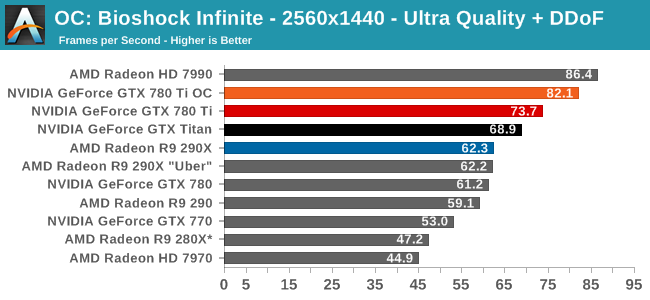
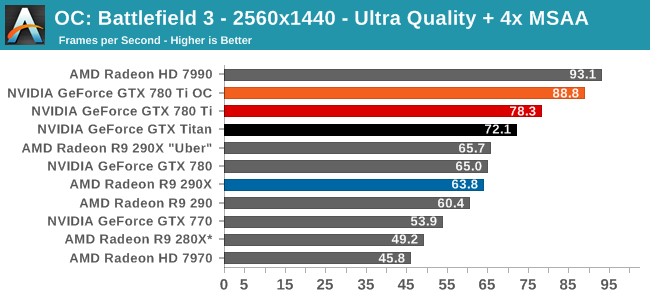
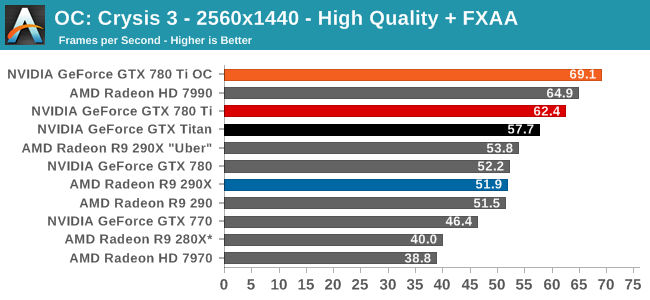
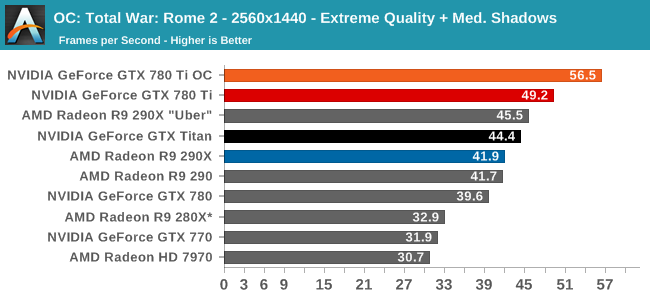
Finally, looking at gaming performance the the overall performance gains for overclocking are generally consistent. Between our 6 games we see a 10-14% performance increase, all in excess of the memory overclock and closely tracking the GPU overclock. GTX 780 Ti is already the fastest single-GPU card, so this only further improves its performance lead. But it does so while cutting into whatever is above it, be it the games where the stock 290X has a lead, or multi-GPU setups such as the 7990.










302 Comments
View All Comments
FuriousPop - Sunday, November 10, 2013 - link
lol. you do realize that those of us running surround/eyefinity need to have a bench to relate to this. Thats what 4k does for us, its not much but its better than just that standard 1600p.in actual fact i am currently gaming close to 8k resolution (eyefinity) so before you rage, take a breath!
yeeeeman - Thursday, November 7, 2013 - link
And, after this replica from nVidia, the 290X still seems the right choice. You strap a water block on it, and it goes like 780Ti, has more memory (4GB) and consumes aprox. the same. You have to be extremely stubborn not to admit the fact that 290X is the right card to get.Kutark - Friday, November 8, 2013 - link
Right, cus the 90-140 dollars for the water block, also making the assumption that you already have all the other requisite shit for water cooling TOTALLY makes it worth it.For someone buying a new card, if they dont already have a water cooling setup, water cooling is a COMPLETE non option.
hero4hire - Sunday, November 10, 2013 - link
Can buy aftermarket air coolers for >$100 too. Only for the tinkerers. I'd rather just see what an aftermarket does and not pretend I'm better. Amd has a laughably bad reference cooler which is why it's so easy to see the weak link. If we didn't see a large performance jump at 100% (60%) fan throttle I'd just call the 290 a bust and move on. I won't buy this gen but I am very interested just as an overclock erscook9 - Thursday, November 7, 2013 - link
AnandTech, PLEASE PLEASE test the 780 Ti against the R9 290x and R9 290 with all of them watercooled at stock clocks. This will be the only real way to tell what card is better than the other with temperatures removed from the equation as clearly temperature wildly influences the overall performance capabilities of these cards.Thanks!
Yojimbo - Thursday, November 7, 2013 - link
Haha if you are going to watercool them, why test them at stock clocks? Because AMD is already more-or-less overclocking their cards and you want to cast AMD in a better light? If you are going to watercool them, then overclock each card aggressively, and test them that way.eanazag - Thursday, November 7, 2013 - link
I'm not sold on the Ti being that strong of a champ. I will say that Nvidia's cooler is by far better and AMD should take note - especially since AMD's temp limit is high. I don't have money for either 780 + or R290 +, but if I was spending Nvidia's position in any category doesn't justify the price. Their wins are not impressive enough for that. $50 more over the R290x is reasonable. The overclocking options look good; without overclocking R290X + $25.looncraz - Thursday, November 7, 2013 - link
Is it just me or do the performance charts not mate up with the words?What I mean is that the charts will show the 290X, in uber mode, beating the 780Ti by 2-3FPS almost across the board and then the text in the article will declare the 780Ti the winner. This is most obvious on the Crysis: Warhead page.
"with the additional performance offered by the GTX 780 Ti NVIDIA is once again at the top, though only by a margin of under 2fps"
That isn't true any way you shake it. The 290X in quiet mode loses by 1.2FPS - at worst - and in uber mode it wins by 2.2FPS.
All I see in the charts from the 780Ti is a card with a slight average advantage at lower resolutions and a more significant loss at higher resolutions. Not a bad card, but I'd call it a tie if anything... a performance difference in the range of 2% between the 290X and Titan was considered a tie... why not now?
mac2j - Thursday, November 7, 2013 - link
Totally agree - and the reviews on other sites are much more balanced from what I've seen so far. I don't think of Ryan as someone who is generally overtly biased, but if you look at the numbers this looks like a huge win for the 290X. In most games the 2 cards are +/- 5% of each other which wouldn't even justify a $100 premium much less $150. On top of that the 290X seems to scale better in CF. Just my interpretation based on the games I play but the "final words" seems very slanted and the "11%" over 290X seems very biased as its not based on Uber mode.venkman - Thursday, November 7, 2013 - link
Maybe this has been asked before, but when are we going to see Benchmarks with the 2013 Fall Games? Battlefield 4/COD: Ghosts/Batman/AC4 etc?